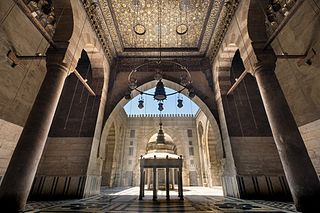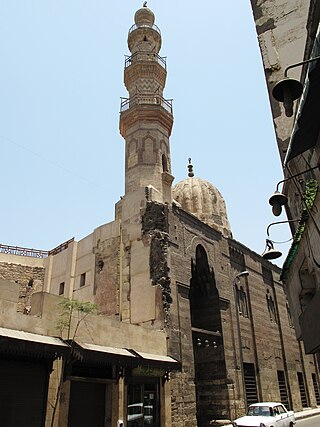
Al-Ashraf Salāh ad-Dīn Khalil ibn Qalawūn was the eighth Bahri Mamluk sultan, succeeding his father Qalawun. He served from 12 November 1290 until his assassination in December 1293. He was well known for conquering the last of the Crusader states in Palestine after the siege of Acre in 1291. While walking with a friend, Khalil was attacked and assassinated by Baydara and his followers, who was then killed under the orders of Kitbugha.

Al-Malik an-Nasir Nasir ad-Din Muhammad ibn Qalawun, commonly known as an-Nasir Muhammad, or by his kunya: Abu al-Ma'ali or as Ibn Qalawun (1285–1341) was the ninth Mamluk sultan of the Bahri dynasty who ruled Egypt between 1293–1294, 1299–1309, and 1310 until his death in 1341. During his first reign he was dominated by Kitbugha and al-Shuja‘i, while during his second reign he was dominated by Baibars and Salar. Not wanting to be dominated or deprived of his full rights as a sultan by his third reign, an-Nasir executed Baibars and accepted the resignation of Salar as vice Sultan.

Al-Malik Az-Zahir Sayf ad-Din Barquq was the first Sultan of the Circassian Mamluk Burji dynasty of Egypt. He deposed sultan al-Salih Hajji to claim the throne for himself. Once in power, he placed many of his family members in positions of power. Rebelling governors in 1389 restored Hajji to the throne but Barquq was able to reclaim the throne shortly after and ruled until his death in 1399 and was succeeded by his son. The name Barquq is of Circassian origin and is his birth name.
Al-Ashraf Ala'a ad-Din Kujuk ibn Muhammad ibn Qalawun, better known as al-Ashraf Kujuk, was the Mamluk sultan from August 1341 to January 1342. He was a young child on the throne, and real power was held by his regent Emir Qawsun, a senior aid to Kujuk's father Sultan an-Nasir Muhammad. When Qawsun was ousted in a mamluk revolt in late December 1341, Kujuk was deposed in the weeks after. Kujuk was later murdered at the age of nine as a result of the political intrigues in the sultanate.

Al-Ashraf Zayn ad-Din Abu al-Ma'ali Sha'ban ibn Husayn ibn Muhammad ibn Qalawun (Arabic: الأشرف زين الدين شعبان, lit. 'The Most Noble, Grace of the Faith, Father of Excellence, Sha'ban son of Husayn, son of Muhammad, son of Qalawun', better known as al-Ashraf Sha'ban (السلطان شعبان or Sha'ban II, was a Mamluk sultan of the Bahri dynasty in 1363–1377. He was a grandson of Sultan an-Nasir Muhammad. He had two sons who succeeded him: al-Mansur Ali and as-Salih Hajji.

Shaykhu al-Umari an-Nasiri was a high-ranking Mamluk emir during the reigns of sultans al-Muzaffar Hajji (1346–1347), an-Nasir Hasan and as-Salih Salih (1351–1355).
Sanjar ibn Abdullah Alam al-Din Abu Sa'id al-Jawli was a powerful Mamluk emir and the Governor of Gaza and much of Palestine between 1311–20 during the sultanate of an-Nasir Muhammad and then again for a brief time in 1342 during the reign of the latter's son as-Salih Ismail. Prior to his first term as governor, al-Jawli briefly served as the Emir of Shawbak in Transjordan and before his second term as Gaza's governor, he was appointed Governor of Hama for three months.
An-Nasir Shihab ad-Din Ahmad ibn Muhammad ibn Qalawun, better known as an-Nasir Ahmad, was the Bahri Mamluk sultan of Egypt, ruling from January to June 1342. A son of Sultan an-Nasir Muhammad, he became embroiled in the volatile succession process following his father's death in 1341. An-Nasir Ahmad lived much of his life in the desert fortress of al-Karak in Transjordan and was reluctant to assume the sultanate in Cairo, preferring al-Karak, where he was closely allied with the inhabitants of the city and the Bedouin tribes in its vicinity. His Syrian partisans, emirs Tashtamur and Qutlubugha al-Fakhri, successfully maneuvered to bring Syria under an-Nasir Ahmad's official control, while sympathetic emirs in Egypt were able to oust the Mamluk strongman Emir Qawsun and his puppet sultan, the five-year-old half-brother of an-Nasir Ahmad, al-Ashraf Kujuk. An-Nasir Ahmad eventually assumed the sultanate after frequently delaying his departure to Egypt.
As-Salih Imad ad-Din Abu'l Fida Isma'il, better known as as-Salih Isma'il, was the Bahri Mamluk sultan of Egypt between June 1342 and August 1345. He was the fourth son of an-Nasir Muhammad to succeed the latter as sultan. His reign saw a level of political stability return to the sultanate. Under his orders or those close to him, his two predecessors and brothers, al-Ashraf Kujuk and an-Nasir Ahmad, were killed. He was succeeded by another brother, al-Kamil Sha'ban.

Al-Muzaffar Sayf ad-Din Hajji ibn Muhammad ibn Qalawun, better known as al-Muzaffar Hajji, was the Bahri Mamluk sultan of Egypt. He was also the sixth son of an-Nasir Muhammad to hold office, ruling from September 1346 and December 1347. He was known for his love of sports and pigeon racing, acts which led to frustration among the senior Mamluk emirs who believed he neglected the duties of office and spent extravagant sums on gambling. His reign ended when he was killed in a confrontation with Mamluk conspirators outside of Cairo.
An-Nasir Badr ad-Din Hasan ibn Muhammad ibn Qalawun, better known as an-Nasir Hasan, was the Mamluk sultan of Egypt, and the seventh son of an-Nasir Muhammad to hold office, reigning twice in 1347–1351 and 1354–1361. During his first reign, which he began at age 12, senior Mamluk emirs formerly belonging to an-Nasir Muhammad, dominated his administration, while an-Nasir Hasan played a ceremonial role. He was toppled in 1351 when he attempted to assert executive authority to the chagrin of the senior emirs. He was reinstated three years later during a coup against his brother Sultan as-Salih Salih by emirs Shaykhu and Sirghitmish.
Sayf ad-Din Baybugha Rus al-Qasimi an-Nasiri was a prominent Mamluk emir during the reigns of sultans as-Salih Isma'il, al-Muzaffar Hajji, an-Nasir Hasan and as-Salih Salih.

As-Salih Salah ad-Din Salih ibn Muhammad ibn Qalawun (28 September 1337–1360/61, better known as as-Salih Salih, was the Mamluk sultan in 1351–1354. He was the eighth son of Sultan an-Nasir Muhammad to accede to the sultanate. He was largely a figurehead, with real power held by the senior Mamluk emirs, most prominently Emir Taz an-Nasiri.

Al-Mansur Salah ad-Din Muhammad ibn Hajji ibn Muhammad ibn Qalawun (1347/48–1398), better known as al-Mansur Muhammad, was the Mamluk sultan in 1361–1363. He ruled in name only, with power held by the Mamluk magnates, particularly Yalbugha al-Umari, al-Mansur Muhammad's regent. The latter had al-Manur Muhammad's predecessor and uncle an-Nasir Hasan killed and al-Mansur Muhammad installed to replace him.

Al-Mansur Ala' ad-Din Ali ibn Sha'ban ibn Husayn ibn Muhammad ibn Qalawun, better known as al-Mansur Ali II, was the Mamluk sultan reigning in 1377–1381. He was installed to the throne while a child by the senior Mamluk emirs after they had rebelled against and killed al-Mansur Ali's father, Sultan al-Ashraf Sha'ban. Al-Mansur Ali was a figurehead, with real power being held by the senior emirs, most prominently Barquq. Al-Mansur Ali died about four years into his reign and was succeeded by his younger brother, as-Salih Hajji, although real power was still held by Barquq, who usurped the throne in 1382.
Baligh ibn Yusuf ibn Tayyi was the Arab commander (muqaddam) of the halqa (non-mamluk) regiment of the fortress of al-Karak in the mid-14th century under the Mamluks. He was a key backer of Sultan an-Nasir Ahmad during the latter's brief reign. However, he ultimately betrayed an-Nasir Ahmad after being recruited by the latter's brother and usurper of the throne, as-Salih Ismail in 1344.
‘Izz al-Dīn Abū Sarī‘ ‘Ajlān ibn Rumaythah ibn Muḥammad Abī Numayy al-Ḥasanī was Emir of Mecca from 1344 and 1372, with interruptions.
Asad al-Dīn Abū Shihāb Thaqabah ibn Rumaythah ibn Muḥammad Abī Numayy al-Ḥasanī was Emir of Mecca six times between 1344 and 1361.
The Buhturids, also known as the Banu Buhtur or the Tanukh, were a dynasty whose chiefs were the emirs of the Gharb area southeast of Beirut in Mount Lebanon in the 12th–15th centuries. A family of the Tanukhid tribal confederation, they were established in the Gharb by the Muslim atabegs of Damascus after the capture of Beirut by the Crusaders in 1110. They were tasked with guarding the mountainous frontier between the Crusader coastlands and the Islamic interior of the Levant. They were granted iqtas over villages in the Gharb and command over its peasant warriors, who subscribed to the Druze religion, which the Buhturids followed. Their iqtas were successively confirmed, decreased or increased by the Burid, Zengid, Ayyubid and Mamluk rulers of Damascus in return for military service and intelligence gathering in the war with the Crusader lordships of Beirut and Sidon. In times of peace the Buhturids maintained working relations with the Crusaders.











